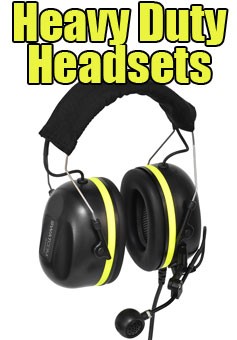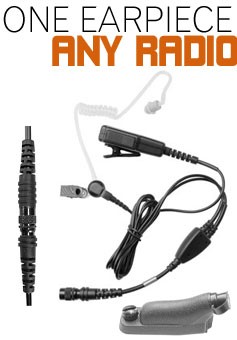
Earpieces have become a fundamental part of our working lives. In various professions, from customer service to transcription, and from telemarketing to broadcasting, earpieces play an integral role. More recently, they have become a ubiquitous part of the remote work setup, facilitating communication in web meetings and virtual events.
Despite their numerous benefits in enhancing our work efficiency, it's crucial to understand the potential risk they pose to our hearing health. Regular and prolonged use of earpieces has the potential to damage our ears, leading to hearing loss or tinnitus. This article will provide an in-depth analysis of how earpieces used at work can damage our ears, and offer suggestions on how to use them responsibly.
In-Ear Earpiece and Its Potential Risks
In-ear earpieces such as acoustic tube earpieces are specifically designed to be inserted directly into the ear. This design feature enables them to provide a degree of isolation from external noise, promoting an immersive listening experience. However, this direct delivery of sound into the ear also has its drawbacks.
When the volume is turned up excessively high or utilized for extended periods, the risk of inducing hearing damage increases significantly. The noise is pumped directly into the ear canal, bypassing many of the natural mechanisms that protect our hearing. Therefore, to maintain healthy hearing, it is recommended to use these types of earpieces responsibly, avoiding high volumes and long-term use.
Over-Ear Earpieces
Over-ear earpieces, such as our Drings and G-shaped models, are designed with a superior sound dispersion system which significantly lowers the sound pressure entering the ear. This feature, inherently, causes less damage to the user's ear, making them a safer choice for consistent use.
However, a notable drawback of these types of earpieces is their susceptibility to high background noise. Since they don't completely seal off the ear canal like in-ear models, ambient sound can easily interfere with the listening experience. This may be a concern for users in noisier environments or those who require a more immersive sound experience.
Prolonged Use and Excessive Volume: The Main Culprits of Hearing Damage
Regardless of age or activity - be it adults engrossed in their work, or young children enjoying their favorite tunes - the common thread that links the risk of hearing damage is the prolonged use of headphones and excessive volume. Extended exposure to increasingly loud noise can lead to trauma caused by auditory stress. Those affected often report a myriad of symptoms, which are evident of the toll taken on our ears.
A muffled sensation in the ear, often described as a feeling of pressure, can be a result of inflammation in the eardrum or ear canal. Tinnitus, a constant and irritating sensation of ringing in the ear, is another common symptom. More severe consequences are outright hearing loss and persistent ear pain. This underscores the necessity to regulate our use of headphones, keeping the volume at a safe level and taking regular breaks to prevent damage to our hearing.
Understanding the Risks: Exposure Level and Duration
The crux of the issue lies in the sustained, high-volume usage of headphones, a habit shared by individuals of all ages, from children lost in their favorite tracks to adults absorbed in their work. This blanket behavior, unfortunately, is leading to an increase in hearing damage across the board.
The repercussions of unregulated exposure to escalating noise levels are severe, often resulting in auditory stress and related trauma. The afflicted individuals typically exhibit a gamut of symptoms, including a blocked feeling in the ear - a consequence of inflammation in the eardrum or ear canal; tinnitus, marked by a constant, bothersome ringing sound; severe ear pain and even total hearing loss.
It is worth noting that the permissible sound exposure level stands at 85 decibels (dBA) for a maximum of 8 hours a day. Yet, health experts caution that even moderate volume levels can pose a threat to our auditory health over time. It's not just the intensity of the noise that inflicts damage, but the duration of exposure as well. Hence, it is crucial to maintain a reasonable volume and take frequent breaks to avert potential harm to our hearing.
Common Warning Signs of Hearing Loss
Signs of hearing loss can sometimes go unnoticed, as they often gradually develop over time. It's vital to recognize the symptoms early to seek appropriate treatment and prevent further deterioration. Here are a few common warning signs:
- Hearing muffled sounds: One of the first and most common signs of hearing loss is perceiving sounds as muffled or far away.
- Difficulty understanding conversations in noisy places: Background noise becomes a significant challenge, making it hard to follow conversations.
- Struggling to hear high-pitched sounds: High-frequency hearing loss is common, leading to difficulty in hearing sounds like a ringing phone or a microwave beep.
- Difficulty in hearing speech consonants: This can make it hard to differentiate words that sound similar, leading to miscommunication.
- Ringing in the ears: Also known as tinnitus, it can be a common symptom of potential hearing damage.
- Repeatedly asking individuals to speak louder or repeat what they said: This could be a sign that normal speech volume isn't clear or loud enough.
- Hypersensitivity to certain sounds: Known as hyperacusis, this could lead to discomfort or pain at certain sound frequencies.
If you notice any of these signs, it's important to consult a healthcare professional. Early detection can lead to more effective treatment and can help to prevent further hearing loss.
Prevention Measures for Earpiece Users
Indeed, the saying 'Prevention is better than cure' holds especially true in the context of preserving our hearing health. Many individuals tend to use earpieces for prolonged periods, such as during long shifts of 12+ hours.
Even though the sound may not be constant, during busy periods with numerous users on a single channel, the 'chat' can be incessant. This leads to substantial exposure to sound and, consequently, potential hearing damage.
The best prevention strategies for such situations include the following:
- Taking off the earpiece during breaks: This gives your ears the much-needed respite from the constant auditory stimulation. It's a simple yet effective way of reducing cumulative noise exposure.
- Keeping the volume at a reasonable level: This cannot be stressed enough. Avoid high volumes, even if the environment is noisy. The permissible sound exposure level is 85 decibels (dBA) for maximum 8 hours a day. Any volume beyond this can potentially harm your hearing health.
- Swapping ears constantly: This strategy helps distribute the audio load between both ears, preventing excessive sound exposure in a single ear.
By implementing these preventive measures, one can significantly reduce the risk of hearing damage caused by prolonged earpiece use. Remember, it's not just about the perception of sound, but also ensuring the health and longevity of your hearing.

















